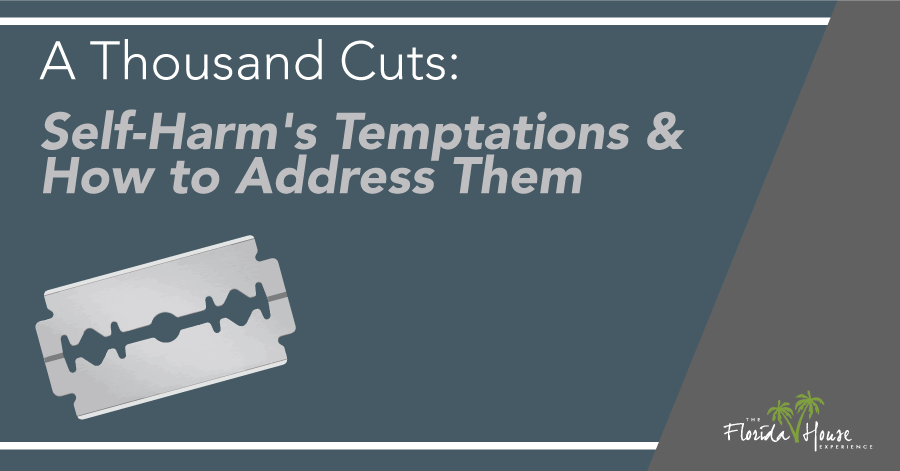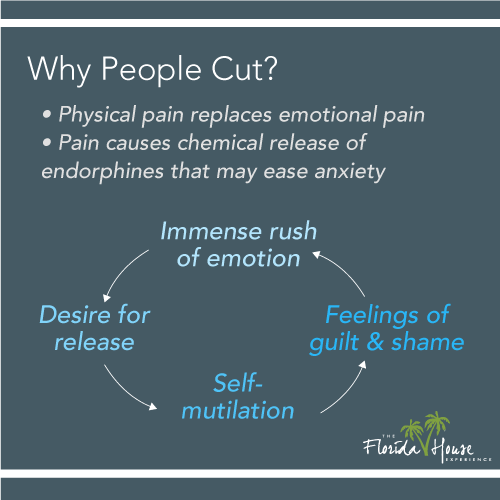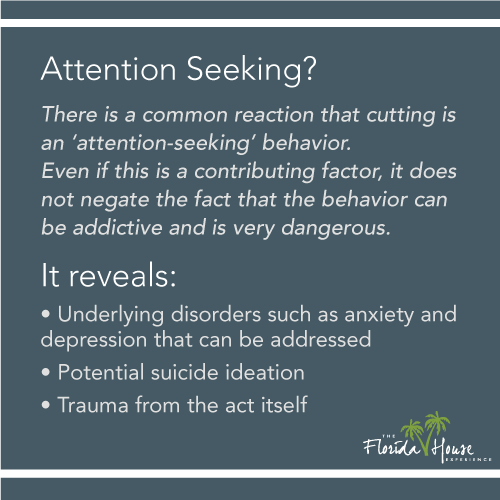
Self-mutilation, or self-injury, is defined as any type of injury a person creates themselves without any intention of suicide. Deliberately harming your body like this can create an emotional release for some people. Most people who cut or burn themselves do so not because they want to kill themselves but as a way of managing frustration and intense anger.
If you or your loved one self-harm, it’s critical to seek help not just for the injury but for the mental illness that’s causing the desire to self-harm. FHE Health can help you with this goal.
Why Do People Intentionally Cut Themselves?
 Many reasons exist for cutting. Many times, a person does so in a moment of intense and overwhelming emotion. Emotional pain tends to be a trigger. Initially, there is a sense of relief or release; yet, within moments, that feeling is gone, often replaced with intense feelings of guilt and shame. This leads to a return to the painful emotions that brought on the cutting.
Many reasons exist for cutting. Many times, a person does so in a moment of intense and overwhelming emotion. Emotional pain tends to be a trigger. Initially, there is a sense of relief or release; yet, within moments, that feeling is gone, often replaced with intense feelings of guilt and shame. This leads to a return to the painful emotions that brought on the cutting.
There’s no simple answer to the question of why this happens in the first place: there are many possible causes. There are two particular issues that tend to be present in those who cut.
Lack of Coping Skills
Most often, a person who cuts suffers from poor coping skills. They simply don’t have the ability to deal with the emotional stress caused by situations that create intense feelings and psychologically challenging circumstances in a healthy manner. Without coping skills, people seek out other ways to reduce the pain.
Poor Emotion Management
Some people lack the ability to understand or express emotion property. Others have a mental health disorder that makes it hard to regulate emotions the way most people do. Cutting often occurs when a person struggling from this condition or another mental health disorder experiences numerous emotions at one time. This could include loneliness, anger, guilt, worthlessness or self-hate.
Which Demographics Are More Prone to Cutting?
Nonsuicidal self-injury is most common in the young adult and teen population. According to a study published in the US National Library of Medicine, between 13 and 50 percent of all teens have engaged in some form of self-harm. What makes pinpointing this rate so challenging is that most people don’t speak about it.
The study also found that as many as 70 percents of teens who engage in self-injury have made at least one attempt at suicide, and 55 percent have tried to commit suicide more than once. Because of this, it’s important to understand and react to the risks.
Why Do I Feel So Calm and Tired After Cutting Myself?
 Many who self-injure don’t have a logical explanation of why they do so and can’t explain why they feel better after cutting. One key reason for this sudden improved mental state is the changes that occur within the body. When a person causes self-harm, the body has a natural reaction that sends endorphins — a feel-good hormone — into the bloodstream.
Many who self-injure don’t have a logical explanation of why they do so and can’t explain why they feel better after cutting. One key reason for this sudden improved mental state is the changes that occur within the body. When a person causes self-harm, the body has a natural reaction that sends endorphins — a feel-good hormone — into the bloodstream.
If you were injured accidentally, the body’s reaction is to release these hormones as a way to create calm and to reduce pain, allowing your brain to work on a solution to the problem. The same conditions apply to cut, creating a sudden release of hormones that help you feel better temporarily.
Cutting also creates a sense of immediate control for many people. For teens and others who feel their lives are controlled by others, cutting can be empowering. For example, a teenage girl may feel overwhelmed by a parent’s decision regarding a relationship, but cutting gives her control over that moment of her life, which feels good emotionally.
Finally, cutting is addictive. Though it may be significantly different than most types of substance abuse, self-injury can become an addiction to the feeling of emotional release. Stopping it may cause anxiety and fear to build up.
Should I Stop Cutting? Why?
Self-harm seems easy enough to manage at that moment. However, it’s risky for your body. Blood infections, skin infections, and disease transfers are possibilities. Additionally, many people who self-harm are at a higher risk for suicide attempts.
On a mental health level, cutting damages you and does nothing to eliminate feelings of self-hatred. Also, self-harm won’t resolve any of the underlying causes prompting someone to cut themselves; it only masks them until they intensify again. Dealing with the mental health aspect of cutting can provide long-term relief from the underlying pain.
Will Your Kids Tell You If They Self-Harm?
Most of the time, those who self-harm have a high level of shame and guilt after doing so. As a result, they rarely confide in anyone. Common symptoms to look for in your child include the following, according to the National Alliance on Mental Illness:
- Fresh cuts, bite marks or wounds of other types that cannot be explained
- Scars, especially those in a pattern
- Frequent reports of injuries
- Holding onto sharp objects
- Rubbing of the skin, which can create a burn-like feeling
- Instability and impulsivity
- Statements about worthlessness and helplessness
- Difficulties with relationships
Cutting is a common form of self-harm, but it’s not the only one. Others include burning, scratching, piercing the skin with a sharp object or inserting objects under the skin. Some also carve words or patterns into the skin. If you notice these in your child, seek out help from our team at FHE Health.
Getting Help for Self-Mutilation at FHE Health
You don’t have to face this challenging, painful life experience on your own. If you are self-harming or your loved one is, seek help immediately. Our professionals at FHE Health are here to help you. Contact us to learn more about treatment options to help you restore your quality of life.






